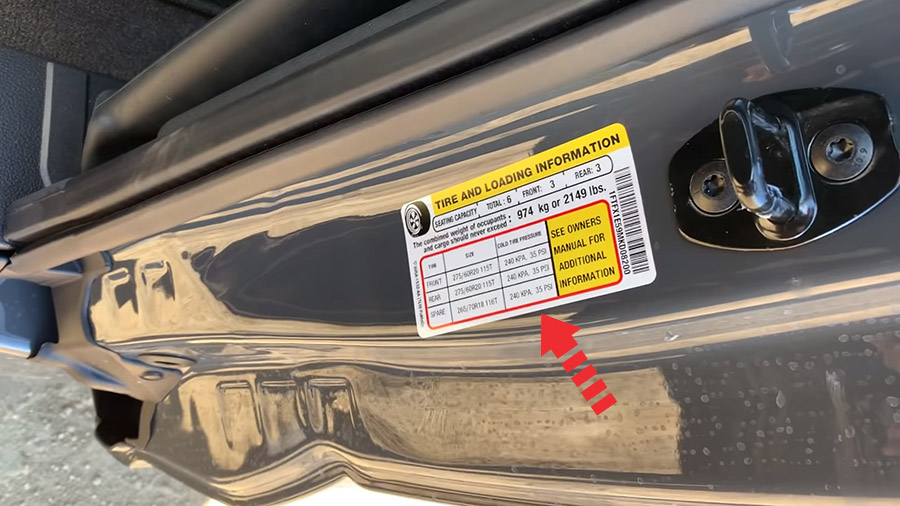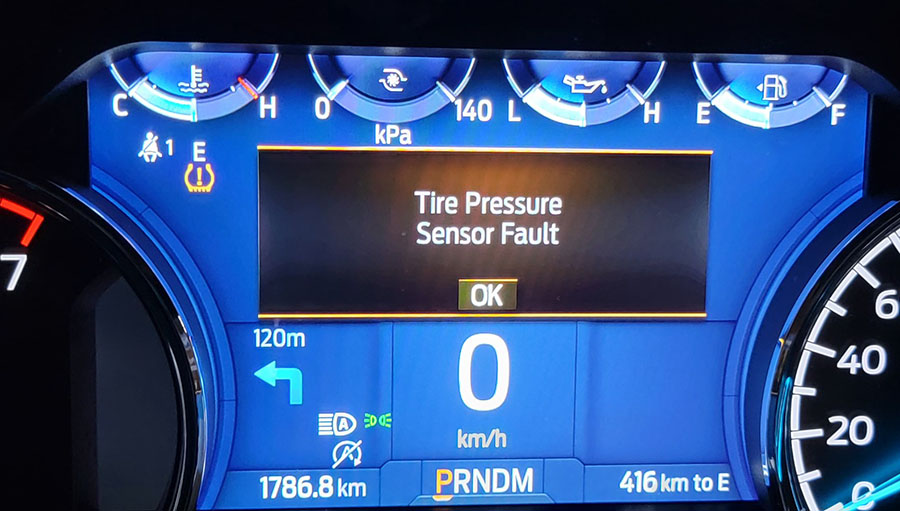The tire pressure monitoring system (TPMS) on Ford F-150 measures the vehicle’s tire pressures. A warning lamp illuminates if one or more tires are significantly underinflated or if there is a system malfunction.

As an added safety feature, Ford F-150 has been equipped with a Tire Pressure Monitoring System (TPMS) that illuminates a low tire pressure light when one or more of your tires is significantly under-inflated. Accordingly, when the low tire pressure light illuminates, you should stop and check your tires as soon as possible, and inflate them to the proper pressure. Driving on a significantly under-inflated tire causes the tire to overheat and can lead to tire failure. Under-inflation also reduces fuel efficiency and tire tread life, and may affect the vehicle’s handling and stopping ability.
Each tire, including the spare (if provided), should be checked monthly when cold and inflated to the inflation pressure recommended by the vehicle manufacturer on the vehicle placard or tire inflation pressure label. (If your vehicle has tires of a different size than the size indicated on the vehicle placard or tire inflation pressure label, you should determine the proper tire inflation pressure for those tires).

Resetting TPMS on F-150
You must reset the tire pressure monitoring system after each tire rotation on F-150 vehicles that require different recommended tire pressures in the front tires as compared to the rear tires.
To reduce the chances of interference from another vehicle, perform the system reset procedure at least three feet, one meter, away from another vehicle undergoing the system reset procedure at the same time.
Do not wait more than two minutes between resetting each tire sensor or the system can time-out and you need to repeat the entire procedure on all four wheels.
- Drive the vehicle above 20 mph (32 km/h) for at least two minutes, then park in a safe location where you can easily get to all four tires and have access to an air pump.
- Switch the ignition off.
- Switch the ignition on but do not start the engine.
- Switch the hazard flashers on then off three times.
Note: You must accomplish this within 10 seconds. If you successfully enter the reset mode, the horn sounds once, the system indicator flashes and a message shows in the information display.
Note: If the system does not enter reset mode, try again starting at Step 2. If after repeated attempts to enter the reset mode, the horn does not sound, the system indicator does not flash and no message shows in the information display, contact your authorized dealer. - Remove the valve cap from the valve stem on the left front tire. Decrease the air pressure until the horn sounds.
Note: The single horn tone confirms that the sensor identification code has been learned by the module for this position. If the horn sounds twice, the reset procedure was unsuccessful, and you must repeat it. - Remove the valve cap from the valve stem on the right front tire. Decrease the air pressure until the horn sounds.
- Repeat the previous step on the right rear tire and then on the left rear tire.
- Switch the ignition off.
Note: If the horn sounds twice again after switching the ignition off, and repeating the procedure, contact your authorized dealer and have your vehicle checked as soon as possible. - Set all four tires to the recommended air pressure as indicated on the Safety Compliance Certification Label.
Tire Pressure Sensor Fault
When the malfunction indicator is illuminated on Ford F-150, the system may not be able to detect or signal low tire pressure as intended. TPMS malfunctions may occur for a variety of reasons, including the installation of replacement or alternate tires or wheels on the vehicle that prevent the TPMS from functioning properly.

Always check the TPMS malfunction indicator after replacing one or more tires or wheels on your vehicle to ensure that the replacement or alternate tires and wheels allow the TPMS to continue to function properly.
TPMS Limitations
- When the outside temperature drops significantly, the tire pressure could decrease and activate the low tire pressure warning lamp.
- The warning lamp could also illuminate when you use a spare wheel, or tire sealant from the inflator kit.
- Regularly checking the vehicle tire pressures can reduce the possibility for the warning lamp to illuminate due to outside air temperature changes.
- After you inflate the tires to the recommended pressure it could take up to two minutes of driving over 20 mph (32 km/h) for the warning indicator to turn off.






